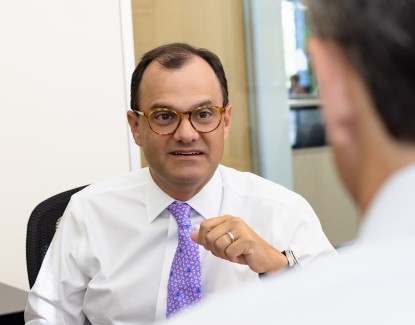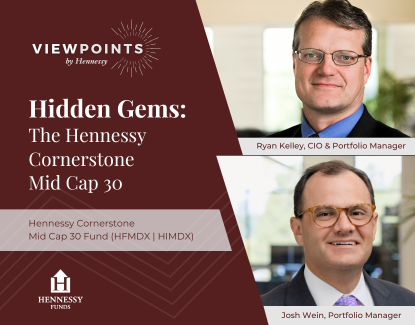Long-term Investing in a Concentrated Collection of Businesses
In the following commentary, the Portfolio Managers of the Hennessy Focus Fund summarize the 2024 market and provide their insights on their 2025 outlook, including the impact on holdings from presidential administration’s policy changes and the growth of AI.
-
 David Rainey, CFACo-Portfolio Manager
David Rainey, CFACo-Portfolio Manager -
 Ira Rothberg, CFACo-Portfolio Manager
Ira Rothberg, CFACo-Portfolio Manager -
 Brian Macauley, CFACo-Portfolio Manager
Brian Macauley, CFACo-Portfolio Manager
Key Takeaways
» The U.S. appears to be in a position of strength as a new presidential administration considers trade negotiations.
» We believe the Fund’s holdings could benefit from the new administration’s focus on reducing regulations, cutting corporate and individual taxes, and implementing tariffs.
» Many portfolio holdings are already benefiting from AI. Two examples include Brookfield Corp. and Applied Materials.
» The Fund’s holdings are predominantly a collection of what we believe to be high-quality growth businesses trading at reasonable valuations.
» We believe the Fund is attractively priced relative to the overall market.
How would you summarize the economy and stock market performance in 2024?
In 2024, the U.S. economy and stock market performed better than our expectations in light of a slowing world economy. It helped that our country holds a commanding lead in innovation across important areas of economic growth, such as data centers, artificial intelligence (AI), semiconductors, and biotechnology. In addition, supply chain concerns are driving investment in manufacturing facilities in the U.S. where energy is abundant and relatively inexpensive. In addition, the U.S. appears to be in a position of strength as a new presidential administration considers trade negotiations.
We believe the Fund’s concentrated portfolio of secular growth businesses is well-positioned in this environment.
How could new presidential administration affect the Fund’s portfolio holdings?
The new administration is focused on reducing regulations, cutting corporate and individual taxes, and implementing tariffs.
1. Reduced regulation – The Department of Government Efficiency (DOGE) plans to recommend a “vast reduction” of federal regulations. These cuts could diminish the workload of government agencies, significantly reducing the number of federal workers as well as department budgets. Less regulation could benefit our holdings by lowering compliance costs and staffing needs while potentially boosting operating income.
2. Tax cuts – Personal income tax cuts set to expire at the end of 2025 could be extended. Also, there could be additional cuts in corporate tax rates as well as tip income, and social security benefit carve-outs from current taxes. Our holdings could benefit by stimulating aggregate demand, which could trigger sales growth and result in overall higher earnings.
3. Trade and tariffs – Proposed tariffs could raise incremental government revenue, reducing the deficit and partially offsetting the stimulative effects of cutting taxes. Some critical imports could be exempt from the tariffs, but a potential negative is that tariffs could increase inflation.
Importantly, by stimulating the supply side of the economy, the new administration’s policies could lift all boats by reducing inflation. Keep in mind that Federal Reserve officials have signaled that additional rate cuts could be on hold given stubborn inflation, a continued strong economy, and low unemployment.
Would you please discuss the top contributors and detractors for 2024?
Over 2024, the top contributors to the Fund’s performance was AST SpaceMobile, Brookfield Corp., and O’Reilly Automotive while the stocks that detracted from performance include Shenandoah Telecommunications, CDW Corp., and American Tower.
Notably, investors were concerned about Brookfield’s commercial office portfolio, but the concern waned as interest rates have stabilized. There was also clarity that the Class A buildings Brookfield owns were doing well in a flight-toquality environment.
At O’Reilly Automotive, the company had another solid year of performance with regard to its comp store sales. Car prices have remained elevated and people have had to spend robustly to maintain their increasingly aged vehicles.
Finally, as it relates to Shenandoah, the wired telecommunication and cable industry has been under pressure due to the growth in fixed wireless broadband coverage to homes. We think Shenandoah is better positioned than larger cable companies to deflect that competitive threat. In addition, the growth of Shenandoah’s fiber optic network is progressing well.
Would you please discuss why AST SpaceMobile deserves its place as the largest Fund holding?
When we added AST SpaceMobile to the Fund, we characterized the investment as a “special situation,” as it did not meet our typical compounder criteria, and gradually added to our position over the past three years. However, our significant proprietary research led us to believe that it has a compelling risk-return profile.
AST’s vision is to be able to provide mobile broadband wireless coverage via satellite to anywhere on earth. We believe recent developments have substantially reduced the risk profile of the investment, while increasing the probability of our upside scenario playing out. These developments include launching the first five commercial satellites and making them operational; raising funds and obtaining strategic partners including AT&T, Google, and Verizon; and complying with the Federal Communications Commission rules.
We discussed AST’s technology, strong partnerships, and solid funding position in a recent shareholder letter. The company is early in its evolution, and many uncertainties remain. But we like how things are developing so far, and think AST shows the hallmarks of a wide moat business with corresponding durable cash flow and premium valuation.
How is the portfolio positioned to benefit from the rapidly growing need for AI technology?
Many portfolio holdings are already benefiting from the growth of AI.
For example, the power consumption of data centers is expected to grow sixfold by 2030. At this rate of growth, additional cost-efficient power is needed for technology behemoths such as Amazon to grow their businesses. The owners and operators of renewable power assets who have access to capital and possess technical expertise are well positioned to meet this demand. One example is Fund holding Brookfield Corp., the world’s largest owner of renewable power assets. Brookfield recently announced an agreement with Microsoft to deliver over 10.5 gigawatts of new renewable power capacity globally. This agreement is almost 8x larger than the largest single corporate power purchase agreement previously signed.
The CEO of Applied Materials, another portfolio holding, believes AI is the biggest inflection of our lifetimes. Power consumption is a critical factor for AI servers due to its impact on operational costs, environmental sustainability, and the ability to scale AI operations effectively. Applied is positioned to capture over 50% of the incremental spending on some of the technologies that will enable performance and power consumption requirements of AI servers. These technologies include gate-allaround transistors and backside power to improve power consumption.
These are only two examples of holdings that stand to benefit from AI. We believe many of our holdings have a sustainable competitive advantage and leading market share in their respective industries. Therefore, these companies benefit from their investment in technology or productivity enhancements to build on their existing advantages.
What is your outlook for equities and the Hennessy Focus Fund?
In terms of our general market outlook, we cannot accurately forecast the market over a one-year horizon on a consistent basis. However, we continue to have a positive long-term outlook. The Fund’s holdings are predominantly a collection of what we believe to be high-quality growth businesses trading at reasonable valuations. Our expectation is that on average, the Fund will own these businesses for five years or longer over this long-term time horizon. With the Fund’s return primarily determined by the growth and earnings power of these businesses, our expectation is for mid-teens earnings growth over the next five years.
We believe the Fund is attractively priced relative to the overall market. At year end, our portfolio is trading at 19.3x our 2025 earnings estimates, compared to 21.4x for the Russell 3000 Index. From this valuation level, we expect portfolio returns will roughly align with the rate of earnings growth produced by our portfolio over the next five years.
- In this article:
- Domestic Equity
- Focus Fund
You might also like
-
 Portfolio Perspective
Portfolio Perspective
Cornerstone Large Growth FundHigh Profitability and Attractive Valuations – A Compelling Combination
 Neil J. HennessyChief Market Strategist and Portfolio Manager
Neil J. HennessyChief Market Strategist and Portfolio Manager Ryan C. Kelley, CFAChief Investment Officer and Portfolio Manager
Ryan C. Kelley, CFAChief Investment Officer and Portfolio Manager L. Joshua Wein, CAIAPortfolio ManagerRead the Commentary
L. Joshua Wein, CAIAPortfolio ManagerRead the CommentaryIn the following commentary, the Portfolio Managers of the Hennessy Cornerstone Large Growth Fund discuss the Fund’s formula-based investment process and how it drives the Fund’s sector and industry positioning.
-
 Portfolio Perspective
Portfolio Perspective
Cornerstone Value FundDriven by Revenues, Cash Flow, and High Dividend Yields
 Neil J. HennessyChief Market Strategist and Portfolio Manager
Neil J. HennessyChief Market Strategist and Portfolio Manager Ryan C. Kelley, CFAChief Investment Officer and Portfolio Manager
Ryan C. Kelley, CFAChief Investment Officer and Portfolio Manager L. Joshua Wein, CAIAPortfolio ManagerRead the Commentary
L. Joshua Wein, CAIAPortfolio ManagerRead the CommentaryIn the following commentary, the Portfolio Managers of the Hennessy Cornerstone Value Fund discuss the Fund’s formula-based investment strategy and how it drives the Fund’s sector and industry positioning.
-
 Viewpoint
ViewpointHidden Gems: The Hennessy Cornerstone Mid Cap 30
 Ryan C. Kelley, CFAChief Investment Officer and Portfolio Manager
Ryan C. Kelley, CFAChief Investment Officer and Portfolio Manager L. Joshua Wein, CAIAPortfolio ManagerWatch the Video
L. Joshua Wein, CAIAPortfolio ManagerWatch the VideoLearn more about the Hennessy Cornerstone Mid Cap 30 Fund, a top-performing strategy that uses a transparent, consistent, disciplined approach to identify undervalued mid and small-cap companies. Portfolio Managers Ryan Kelly and Josh Wein explain their time-tested formula and discuss why it consistently outperforms the market.
